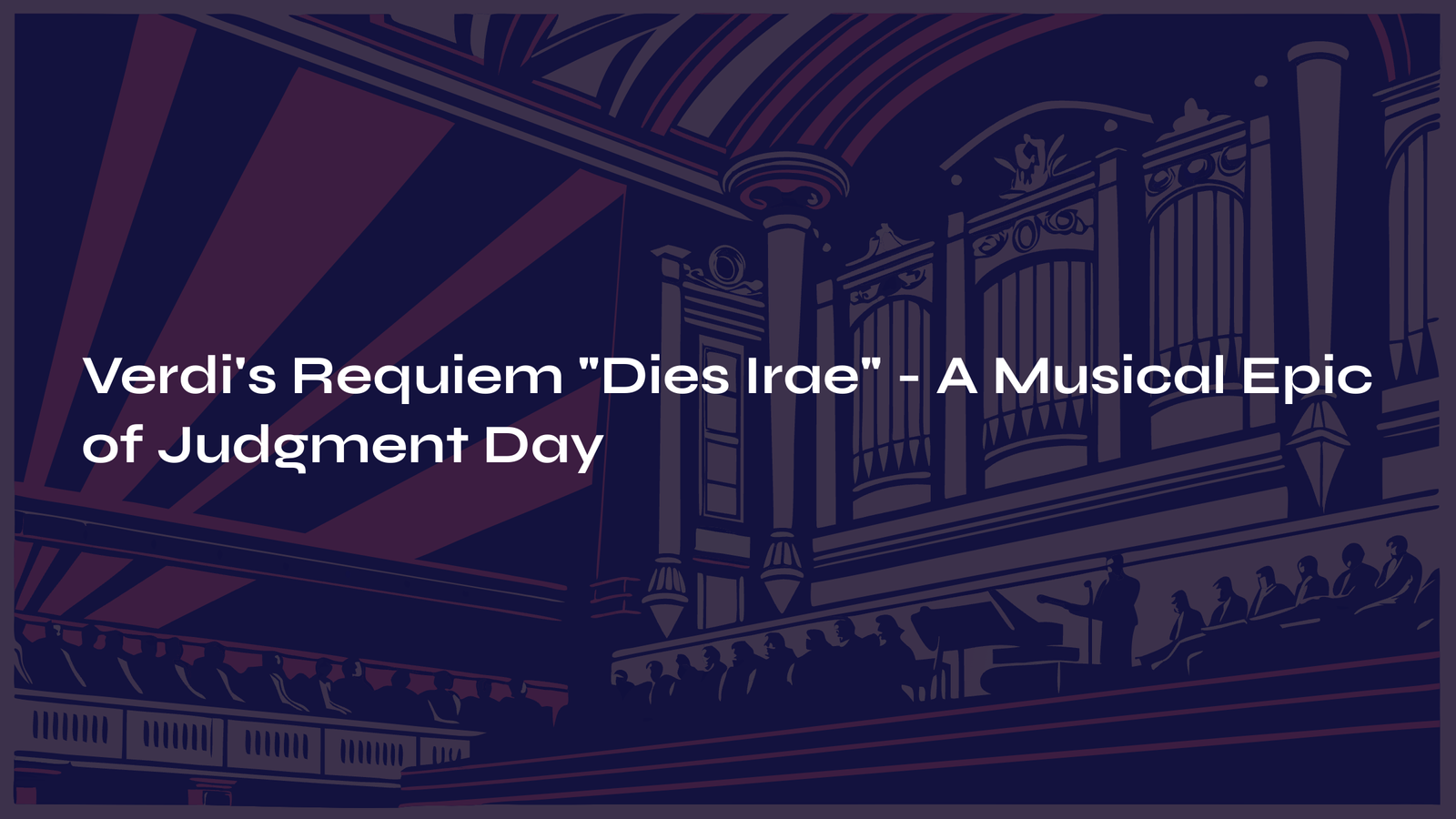Table of Contents
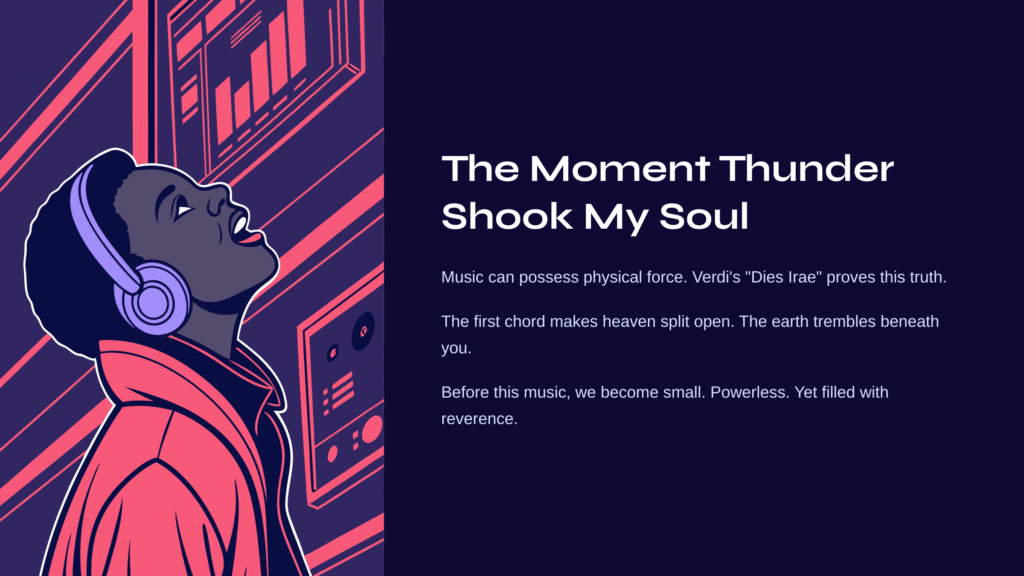
The Moment Thunder Shook My Very Soul
Do you believe music can possess physical force? I found my answer while listening to Verdi’s Requiem “Dies Irae.” The moment the first chord thundered forth, I felt as if the heavens split open and the earth trembled beneath me—a tremor that coursed through my entire being.
Before this music, I become small. Powerless. And simultaneously, ineffably reverent. Verdi’s depiction of “Judgment Day” transcends mere religious imagination; it is a masterpiece that transforms humanity’s most fundamental fears and hopes into pure sound.
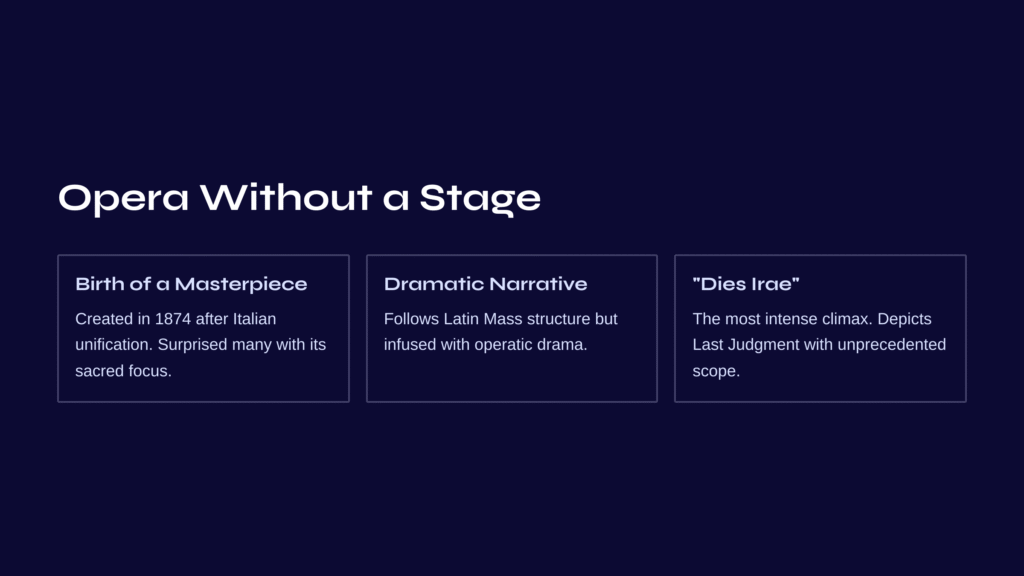
The Greatest Stage Ever Conceived by an Opera Composer
Verdi’s Requiem was born in 1874, shortly after the completion of Italian unification. That the master of opera would suddenly turn his hand to sacred music surprised many. But listening reveals the truth: this Requiem is essentially an opera without a stage.
While following the traditional structure of the Latin Mass, Verdi infused each movement with dramatic narrative. Among these, the “Dies Irae” forms the most intense climax. This movement, meaning “Day of Wrath,” depicts the Last Judgment and represents the pinnacle of Verdi’s dramatic sensibility—a musical epic of unprecedented scope.
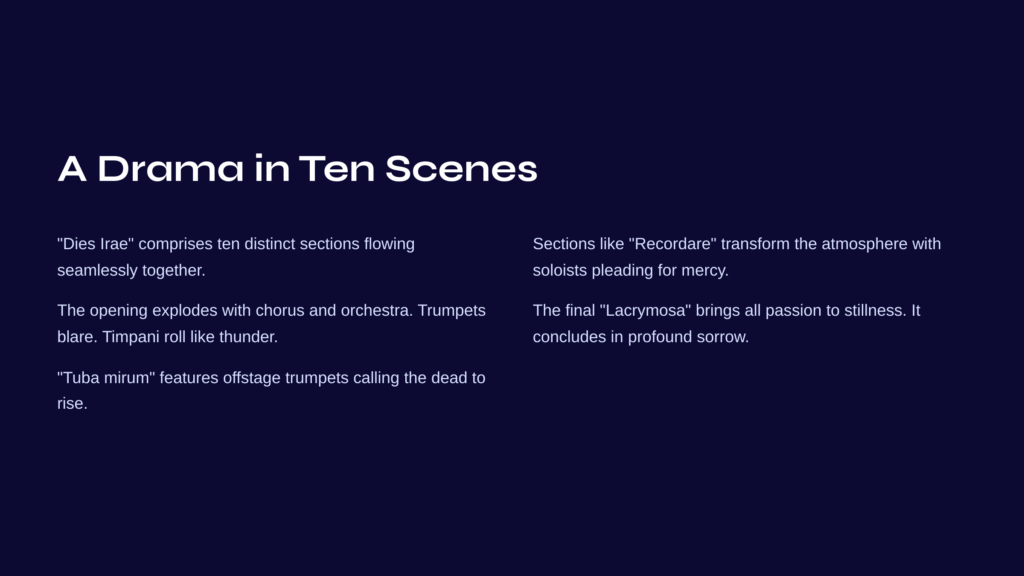
A Drama of Judgment Unfolding in Ten Scenes
Though “Dies Irae” appears as a single extended movement, it actually comprises ten distinct sections, like scenes from an opera flowing seamlessly together.
The opening “Dies Irae” explodes with chorus and orchestra proclaiming Judgment Day in unison. The sound is truly overwhelming—trumpets blaring infernal fanfares, timpani rolling like thunder, the chorus crying “Dies irae, dies illa!” (Day of wrath, that day!).
In “Tuba mirum,” four trumpets positioned offstage sound the call to resurrect the dead. This spatial effect creates an otherworldly mysticism, as if sounds emanate from another dimension entirely.
Then the atmosphere transforms completely in sections like “Recordare” and “Ingemisco.” Soloists emerge to sing heartbreaking melodies pleading for divine mercy. These dramatic contrasts epitomize Verdi’s unique theatrical instinct.
The final “Lacrymosa” (Day of Tears) brings all passion to stillness, concluding in profound sorrow. The fugato here poignantly expresses human frailty and humility before death.
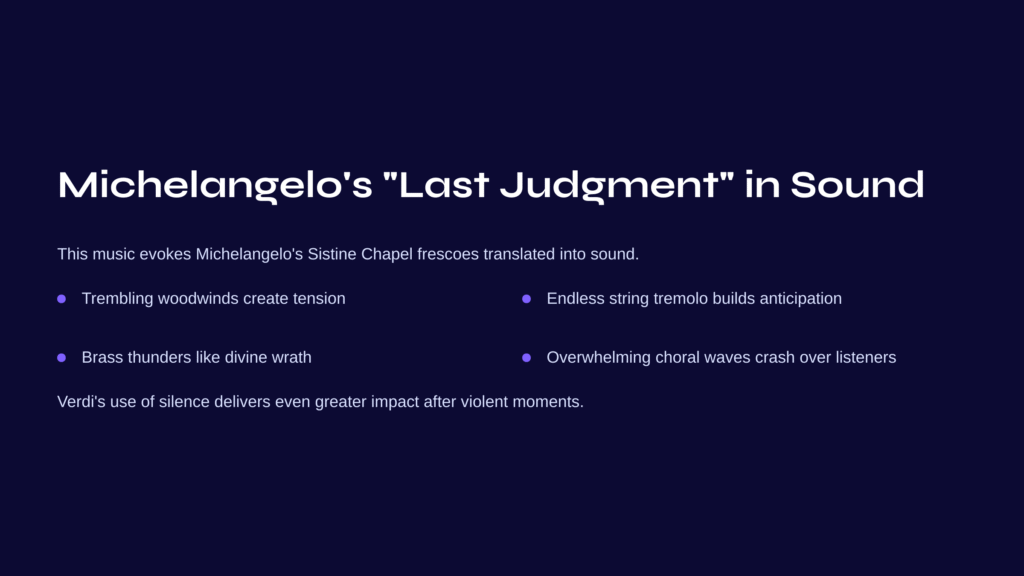
Michelangelo’s “Last Judgment” Rendered in Sound
Listening to this music, I invariably envision Michelangelo’s Sistine Chapel frescoes. Verdi’s “Dies Irae” seems to translate that monumental painting into pure sound.
The orchestration operates on a truly colossal scale: trembling woodwinds, endless string tremolo, brass thundering like divine wrath, and above it all, waves of overwhelming choral sound. These elements unite to create the most powerful acoustic force human art can achieve.
Particularly striking is Verdi’s use of silence. The sudden quiet that follows the most violent moments delivers even greater impact. Like the stillness after a storm, in that silence we hear our own heartbeats echoing in the void.
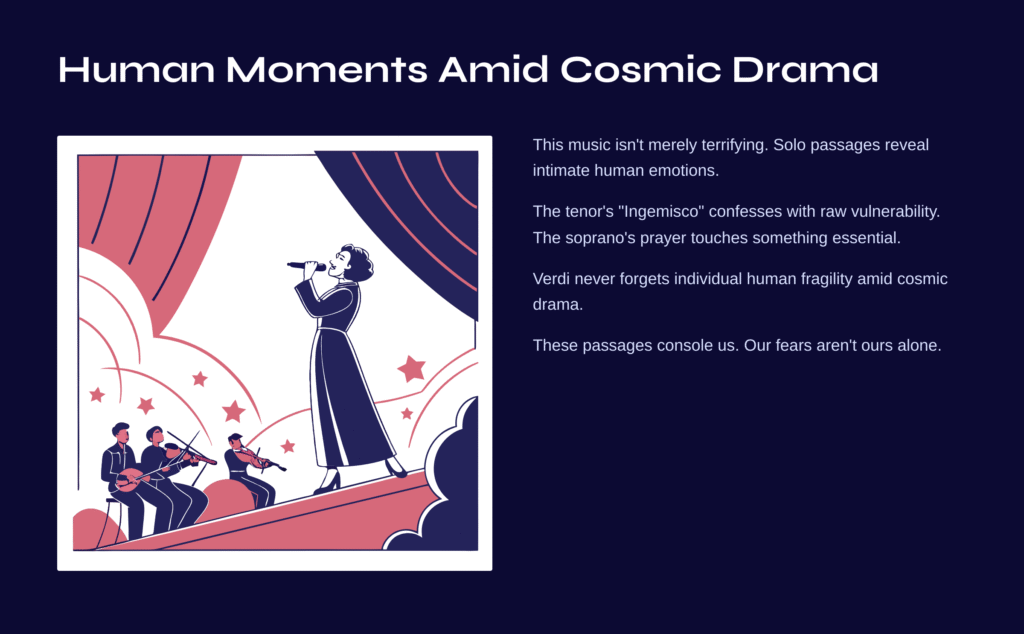
Human Moments Where Terror and Comfort Intersect
This music isn’t merely terrifying. The solo passages reveal surprisingly intimate human emotions.
When the tenor sings “Ingemisco” confessing “I groan as a sinner,” the raw vulnerability pierces the heart. The soprano and mezzo-soprano’s urgent prayer in “Recordare” touches something essential. In these moments, Verdi shows that even within cosmic drama, he never forgets individual human fragility.
These passages console me. Ah, this fear and anxiety isn’t mine alone. Verdi centuries ago, and everyone who hears this music, shares the same human limitations—a profound sense of solidarity emerges.

Practical Advice for Experiencing Verdi’s “Dies Irae”
For first-time listeners, I offer these suggestions:
First, use excellent audio equipment. The overwhelming power of this music cannot be conveyed through small speakers. If possible, I strongly recommend experiencing it live in a concert hall.
Second, familiarize yourself with the text beforehand. Though in Latin liturgical language, reading translations will make the music far more vivid and immediate.
Third, don’t try to understand everything at once. This work reveals new facets with each hearing. Initially, simply surrender to its massive energy, then gradually discover the details in subsequent listenings.

A Song of Timeless Fear and Hope
Every time I hear Verdi’s “Dies Irae,” I wonder: how different are we from people 150 years ago? Technology has advanced, but aren’t fear of death and longing for salvation still humanity’s most fundamental emotions?
This music addresses eternal themes. That’s why it continues to move people across centuries. Verdi’s sonic epic asks us: How are you living? For what are you praying?
Beautiful questions. And in seeking their answers, we become, alongside this music, a little deeper, a little more humble, a little more human.
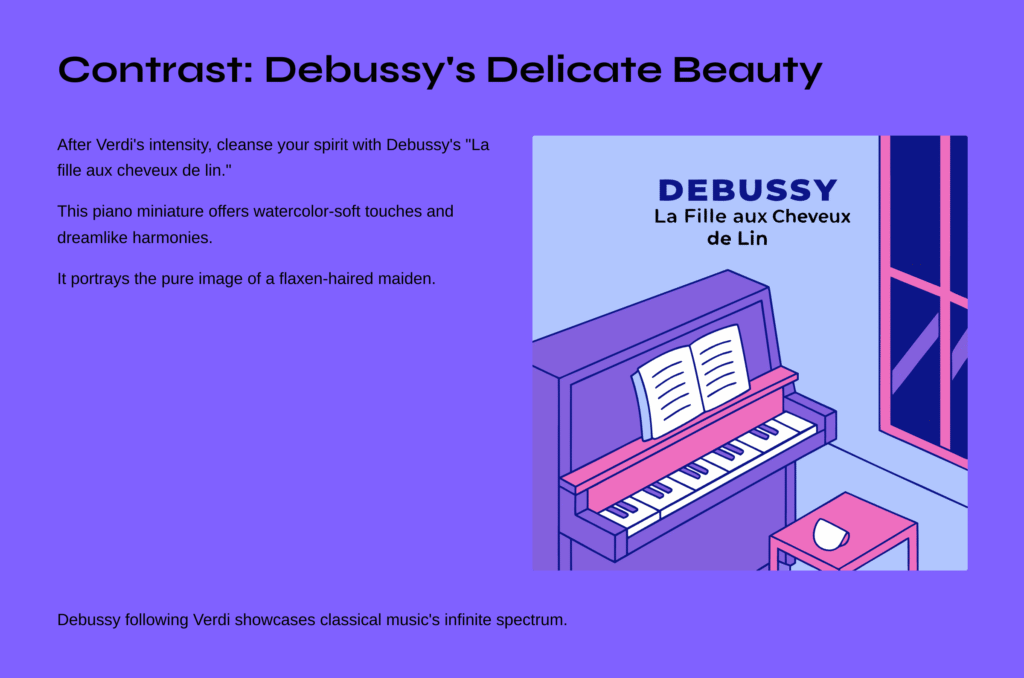
Toward the Delicate Beauty of Impressionist Music
After experiencing Verdi’s intense drama, why not cleanse your spirit with music of completely different character? Debussy’s “La fille aux cheveux de lin” (The Girl with the Flaxen Hair) offers attractions opposite to Verdi’s.
This piano miniature represents the pinnacle of French Impressionist music, characterized by watercolor-soft touches and dreamlike harmonies. Debussy’s delicate piano melodies following Verdi’s massive orchestral sounds will feel like peaceful evening after a storm.
This piece draws inspiration from Scottish poet Leconte de Lisle’s verse, musically portraying the pure, dreamlike image of a flaxen-haired maiden. The lyricism of Debussy following Verdi’s grandeur creates a perfect combination showcasing classical music’s infinite spectrum.
